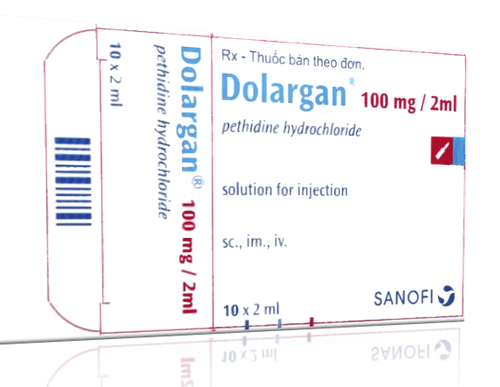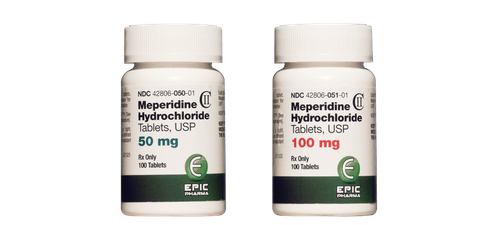This is an automatically translated article.
Dolargan is commonly used to manage moderate to severe pain, including pain during childbirth. The drug is used in injection form, before surgery and in anesthesia, analgesia after surgery. Dolargan may be used for some other problems that are not covered in this guide.
1. What is Dolargan?
Dolargan is a central nervous system pain reliever whose main ingredient is Pethidine Hydrochloride. This active ingredient has similar properties to Morphine, but it acts faster and has a shorter duration of action.Dolargan is usually indicated for pain relief in cases of moderate to severe pain. The drug is also prepared in the form of ampoules of 100mg/2ml, used by injection for pre-anesthesia and anesthesia support.
Indications for Dolargan:
Severe pain that cannot be controlled by conventional pain relievers; biliary, true, and ureteric colic; Preoperative anesthesia; Pulmonary edema, cardiac asthma due to acute left ventricular failure; The pain caused by the tumor cannot be controlled.

Dolargan được dùng trong kiểm soát những cơn đau vừa và nặng
2. Instructions for using Dolargan
Because Dolargan is an injectable drug, patients need to seek the help of medical staff to use.
2.1. Dosage for adults To control moderate and severe pain, patients will receive 25-100mg of Dolargan intramuscular or subcutaneous injection or 25-50mg slow intravenous infusion; To relieve pain during childbirth, pregnant women will be injected intramuscularly or subcutaneously 50-100mg of Dolargan drug. The interval between doses is 1-3 hours if the pain is still severe. However, do not use more than 400mg Dolargan in 1 day; For preoperative pain relief, give the patient 50-100mg of the drug about 1 hour before surgery; For postoperative pain relief, the patient was given a slow intravenous infusion of 10-25mg Dolargan. However, this dose should not be used in the elderly. To ensure the safety of elderly patients, you should consult your doctor about the correct dosage. 2.2. Pediatric Dosage For moderate to severe pain control, 0.5-2mg/kg intramuscularly in children; For surgical prophylaxis, intramuscularly in children 1-2mg/kg 1 hour before surgery. * Note:
For pediatric patients, every time the drug is injected, it is necessary to have the supervision of a parent or a medical professional to minimize possible side effects; After the injection is complete, you can gently massage the injection site to reduce discomfort; Follow the instructions and instructions of the doctors and medical professionals exactly. If you have any questions about the use and dosage of the drug, you should actively discuss to understand more information.

Người bệnh nên dùng thuốc Dolargan đúng liều lượng
3. Side effects of the drug Dolargan
During the use of Dolargan pain relievers, users may experience some unwanted side effects such as:
Arrhythmia, abnormally fast heart. Have other heart problems such as heart edema ; Occurrence of symptoms of low blood pressure, respiratory failure, dizziness, severe headache, drowsiness, nausea, sweating even when in a cool environment; Intestinal spasms, accompanied by abdominal pain symptoms (dry mouth, constipation...); Difficulty urinating, the frequency of urination is markedly reduced and painful feeling when going to the toilet; skin rash, pain at the injection site, and possible mild irritation when injected; Central nervous system problems such as: muscle weakness, loss of coordination, difficulty moving muscles, convulsions, vision disturbances, hallucinations.
4. Notes when using Dolargan
The patient's existing medical condition may affect the use of Dolargan pain relievers. Tell your doctor if you have any health problems, especially:
Respiratory failure ; Obstruction of the respiratory tract; Asthma ; Hypersensitivity to any of the ingredients in the drug; Are pregnant or breastfeeding. There is no complete information about the risks of taking Dolargan during pregnancy or breastfeeding. However, to be on the safe side, always consult your doctor to weigh the benefits and risks. Dolargan may still harm a baby if the mother takes it while breastfeeding.
5. Dolargan drug interactions
Another thing to watch out for when taking Dolargan is possible drug interactions. In some cases, the simultaneous use of many drugs can reduce the effectiveness of the drug or cause unpleasant reactions to the user's health. Dolargan pain relievers may interact with the following drugs:
MAO inhibitors; Cimetidine antacid ; Parasympathetic parasympathetic drugs; Phenothiazines; Drugs that depress the central nervous system such as antidepressants, anxiolytics, sleeping pills, pain relievers, anesthetics or beer/alcohol, etc. To minimize possible side effects, Patients should adhere to the correct injection schedule, dose, avoid drug interactions ... as directed by the doctor. If you notice any unusual symptoms while taking this medicine, you should immediately notify your healthcare provider.
Please dial HOTLINE for more information or register for an appointment HERE. Download MyVinmec app to make appointments faster and to manage your bookings easily.













